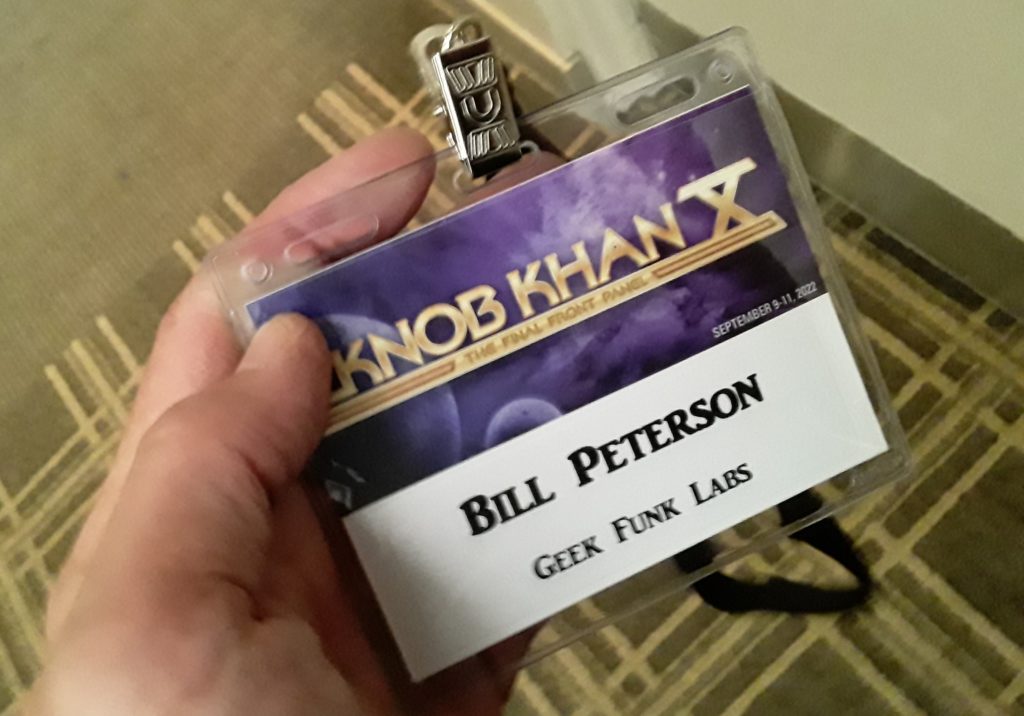Post Knobcon Recap
It was an interesting three days at Knobcon. I played with a lot of different gear, learned some stuff, saw some cool performances, met lots of people. Everyone I talked to was super friendly and relaxed, and willing to let me bombard them with questions about their gear or their business. I was surprised to meet a lot of exhibitors there who are just one-person operations like me – some who have designed small DIY gadgets like the SquishBox, and some who are putting out pro-grade synth modules and keyboards. It’s surprising how far you can go on your own.
Performances: The Friday Night reception had a bunch of great acts. The highlight for me was Too Mere playing the Synthstrom Deluge – he played it handheld rather than hunched over it on a table, and his dancing around while he poked all those flashy buttons and morphed from one beat to the next made for an entertaining show. The other acts were a good opener for the weekend too, and after meeting with some people and chatting I found myself just leaning back in a contented zen state watching the video effects and letting the synth textures wash through my head. Saturday night’s shows gave me more synth to enjoy. I had a good time watching the Supper Club jam in the pavilion, seeing musicians jam out some more old-school funk tunes like I’m used to, with a mix of synth and non-synth instruments.
Workshops: I went to a lot of these. Scott Danesi took us through his journey of creating a modern custom pinball machine with a kickin’ synth soundtrack, and it made obvious the shared skills and DNA of a project like this and what goes into creating synths and music gear. Mike Beauchamp from Therevox shared a history of the Ondes Martneot, a vintage monophonic synth that uses a string-operated potentiometer to set note frequency, and his quest to recreate it in modern form. Marc Doty gave a history of polyphony in synthesizers, ostensibly focused on how we should think about the definition of certain synth terms, but really I think a discussion of what a synthesizer should do. How should we control it? How should it reproduce notes and be able to articulate them?
I think the big takeaway for me from the weekend was that I am a huge noob when it comes to synths. This wasn’t news to me, but although I conceptually understand how something like a rackmount synth or a Minimoog works, the complexity of the actual things are mind-boggling, and it’s impressive to see what a huge community of musicians there is that’s into them. Then there’s the proliferation of grooveboxes, samplers, video effects – it’s amazing to see the different ways people make music.
It also makes me think about my place in all of it. I’m interested in the theory of synthesis, and might even pick up some kind of all-in-one modeling synth keyboard to play around with at some future point, but I don’t plan to get heavy into analog synthesizers, constructing new sounds from raw oscillations and using them in my music. I’ve always enjoyed software synths and MIDI, and I feel like with a software synth you have the flexibility and versatility to create some truly amazing sounds, even though the oscillations aren’t “pure” as they are in analog electronics. Also, I want my sounds to be free of a specific gadget, to be expressible as ones and zeros of a sample or code. That’s why I made the SquishBox – it’s a software synth in a box, but the same code can run on a desktop machine in different OSes and produce the same sound. Maybe there’s room for a soundfonts talk at a future Knobcon?

Hi Bill, Im delighted to hear you are out and about digging in to the world of music synthesis. Keep doing what you are doing and making what you want to make. Its easy to get bombarded by choice and end up just chewing a piece of carpet in the corner. Looking forward to your next releases / findings. Did you get anywhere with the Pi Zero 2W at all? Best wishes, Wayne.
Thanks! Good advice, too. I did get a SquishBox up and running with a Pi Zero 2W – as advertised it has pretty much the same power as a Pi 3B+ (though without all the USB ports), so it works just fine. I even made an updated case model which can accept either a Pi Zero or a Pi 3/4 (just needs a specific lid), and extra ports to run cables for power, USB, and/or HDMI – useful if you want to use a Pi Zero. Hopefully I can post something about that soon. Good to hear from you!